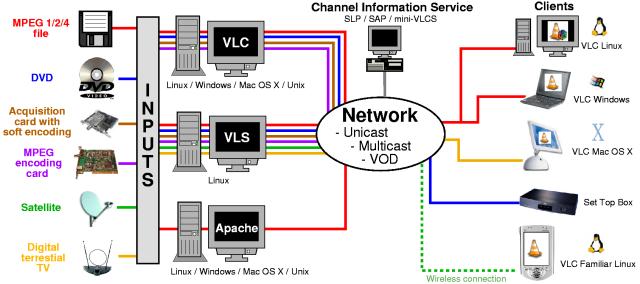1.1. What is the VideoLAN project ?
1.1.1. Overview
VideoLAN is a complete software solution for video streaming, developed by students of the Ecole Centrale Paris and developers from all over the world, under the GNU General Public License (GPL). VideoLAN is designed to stream MPEG videos on high bandwidth networks.
The VideoLAN solution includes :
the VideoLAN Server (VLS), which can stream MPEG-1, MPEG-2 and MPEG-4 files, DVDs, digital satellite channels, digital terrestial television channels and live videos on the network in unicast or multicast,
the VideoLAN Client (VLC), which can be used as a server to stream MPEG-1, MPEG-2 and MPEG-4 files and DVDs on the network in unicast or multicast ; or used as a client to receive, decode and display MPEG streams under multiple operating systems.
Here is an illustration of the complete VideoLAN solution :
More details about the project can be found on the VideoLAN Web site.
1.1.2. VideoLAN software
1.1.2.1. VideoLAN Client
The VideoLAN Client (VLC) works on many platforms : Linux, Windows, Mac OS X, BeOS, *BSD, Solaris, Familiar Linux, Yopy/Linupy and QNX. It can read :
MPEG-1, MPEG-2 and MPEG-4 / DivX files from a hard disk or a CD-ROM drive,
DVDs and VCDs,
from a satellite card,
MPEG-1, MPEG-2 and MPEG-4 streams from the network sent by VLS or VLC's stream output.
VLC can also be used as a server to stream :
MPEG-1, MPEG-2 and MPEG-4 / DivX files,
and DVDs,
to :
one machine (i.e. to one IP address) : this is called unicast ;
a dynamic group of machines that the clients can join or leave (i.e. to a multicast IP address) : this is called multicast.
 | VLC doesn't work on Mac OS 9, and will probably never do. |
1.1.2.2. VideoLAN Server
The VideoLAN Server (VLS) can stream :
an MPEG-1, MPEG-2 or MPEG-4 files stored on a hard drive or on a CD,
a DVD located in a local DVD drive or copied on a hard disk,
a satellite card or a digital terrestial television card,
an MPEG encoding card ;
to :
one machine (i.e. to one IP address) : this is called unicast ;
a dynamic group of machines that the clients can join or leave (i.e. to a multicast IP address) : this is called multicast.
A Pentium 100 MHz with 32 MB of memory should be enough to send one stream on the network. When streaming a lot of videos stored on a hard drive, the actual limitation is not the processor but the hard drive and the network connection.
VLS works under Linux and Mac OS X.
